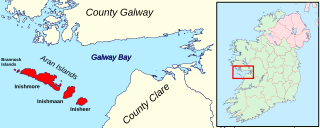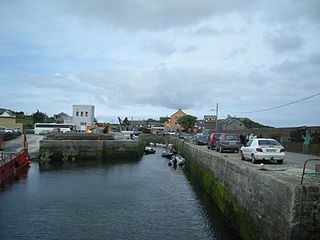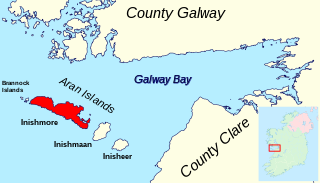Related Research Articles

Galway Bay is a bay on the west coast of Ireland, between County Galway in the province of Connacht to the north and the Burren in County Clare in the province of Munster to the south; Galway city is on the northeast side. The bay is about 50 kilometres (30 mi) long and from 10 kilometres (6 mi) to 30 kilometres (20 mi) in breadth. The Aran Islands are to the west across the entrance and there are numerous small islands within the bay. To the west of Galway, the rocks are granite but to the south they are limestone.

The Aran Islands or The Arans are a group of three islands at the mouth of Galway Bay, off the west coast of Ireland, with a total area around 46 km2 (18 sq mi). They constitute the historic barony of Aran in County Galway.

Connemara is a region on the Atlantic coast of western County Galway, in the west of Ireland. The area has a strong association with traditional Irish culture and contains much of the Connacht Irish-speaking Gaeltacht, which is a key part of the identity of the region and is the largest Gaeltacht in the country. Historically, Connemara was part of the territory of Iar Connacht. Geographically, it has many mountains, peninsulas, coves, islands and small lakes. Connemara National Park is in the northwest. It is mostly rural and its largest settlement is Clifden.

Martin Faranan McDonagh is a British-Irish playwright and filmmaker. He is known for his absurdist black humour which often challenges the modern theatre aesthetic. He has received numerous accolades including an Academy Award, six BAFTA Awards, four Golden Globe Awards, three Olivier Awards, and nominations for five Tony Awards.

Inishmaan is the middle of the three main Aran Islands in Galway Bay, off the west coast of Ireland. It is part of County Galway in the province of Connacht. Inishmaan has a population of about 184, making it the smallest of the Aran Islands in terms of population. It is one of the most important strongholds of traditional Irish culture. The island is predominantly Irish-speaking and part of the Gaeltacht, though all inhabitants have knowledge of English.
This is a bibliography of works relating to the Aran Islands.
Saint Enda of Aran is an Irish saint. His feast day is 21 March.

Cleggan is a fishing village in County Galway, Ireland. The village lies 10 km (7 mi) northwest of Clifden and is situated at the head of Cleggan Bay.

Inishmore is the largest of the Aran Islands in Galway Bay, off the west coast of Ireland. With an area of 31 km2 (12 sq mi) and a population of 820, it is the second-largest island off the Irish coast and most populous of the Aran Islands.

Saint Féchín or Féichín, also known as Mo-Ecca, was a 7th-century Irish saint, chiefly remembered as the founder of the monastery at Fore (Fobar), County Westmeath.

Inishmore Aerodrome is located 1 nautical mile southeast of Kilronan, a town on the island of Inishmore, one of the Aran Islands off the coast of County Galway in Ireland. It has one paved runway designated 14/32 which measures 490 by 18 m.

Inisheer Aerodrome is located on the island of Inisheer, one of the Aran Islands in Galway Bay off the coast of County Galway, Ireland. This aerodrome is licensed by the Aeronautical Services Department of the Irish Aviation Authority.

Inishmaan Aerodrome is located on the island of Inishmaan, one of the Aran Islands in Galway Bay off the coast of County Galway, Ireland. This aerodrome is licensed by the Aeronautical Services Department of the Irish Aviation Authority.
Gormgal of Ardoileán, Connemara, died 1017/1018.

Aer Arann Islands is an Irish airline headquartered in Inverin, County Galway. They operate a three-strong fleet of Britten-Norman BN-2 Islander aircraft to connect the Aran Islands with mainland County Galway.

Connemara Airport or Connemara Regional Airport is located at Inverin in the Connemara region of Ireland, 15 nautical miles west of the city of Galway. It is also known as Spiddal Airport, Inverin Airport, or Minna Airport, a name also used by Minna Airport in Minna, Nigeria.

Renvyle or Rinvyle is a peninsula and electoral division in northwest Connemara in County Galway, close to the border with County Mayo in Ireland.

The Aran Islands is a four part collection of journal entries regarding the geography and people of the Aran Islands. It was completed by John Millington Synge in 1901 and first published in 1907. It is based on Synge's multiple travels through the Irish speaking and predominately rural set of islands off the Western coast of Ireland. The book presents many of the local specificities of the Aran Island people while simultaneously contextualizing the Aran Islands as part of broader European and global commercial networks.

Craggy Island is a fictional island, supposedly off the west coast of Ireland, which serves as the primary setting for the Channel 4 sitcom Father Ted. Craggy Island Parochial House is located on the island, which is the home of three Catholic priests – Father Ted Crilly, Father Dougal McGuire and Father Jack Hackett – as well as their housekeeper Mrs Doyle. It is mentioned the Irish state have given the British government permission to use the island's coast as a dumping ground for nuclear waste.

Templesaghtmacree is an Early Christian church and National Monument located on Inishmaan, Ireland.
References
- ↑ "St Ceannanach's Church at Ballynakill in Co Galway". The Journal Of Antiquities. 17 March 2014. Retrieved 5 July 2023.
- ↑ "St Ceannanach's Church at Ballynakill in Co Galway". The Journal Of Antiquities. 17 March 2014. Retrieved 5 July 2023.
- ↑ "St Ceannanach's Church at Ballynakill in Co Galway". The Journal Of Antiquities. 17 March 2014. Retrieved 5 July 2023.
- A Guide to Connemara's Early Christian Sites, Anthony Previte, Oughterard, 2008. ISBN 978-0-9560062-0-2